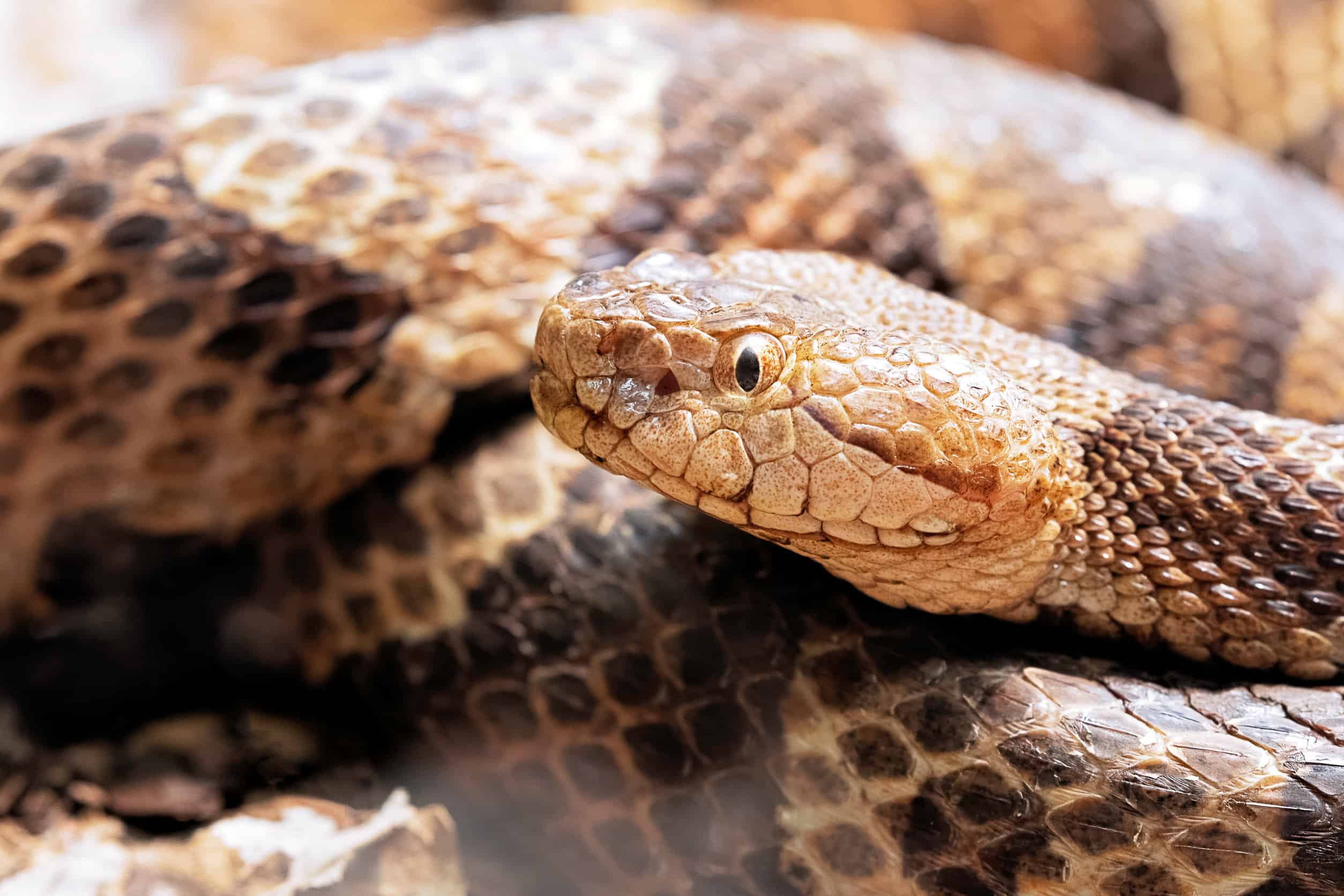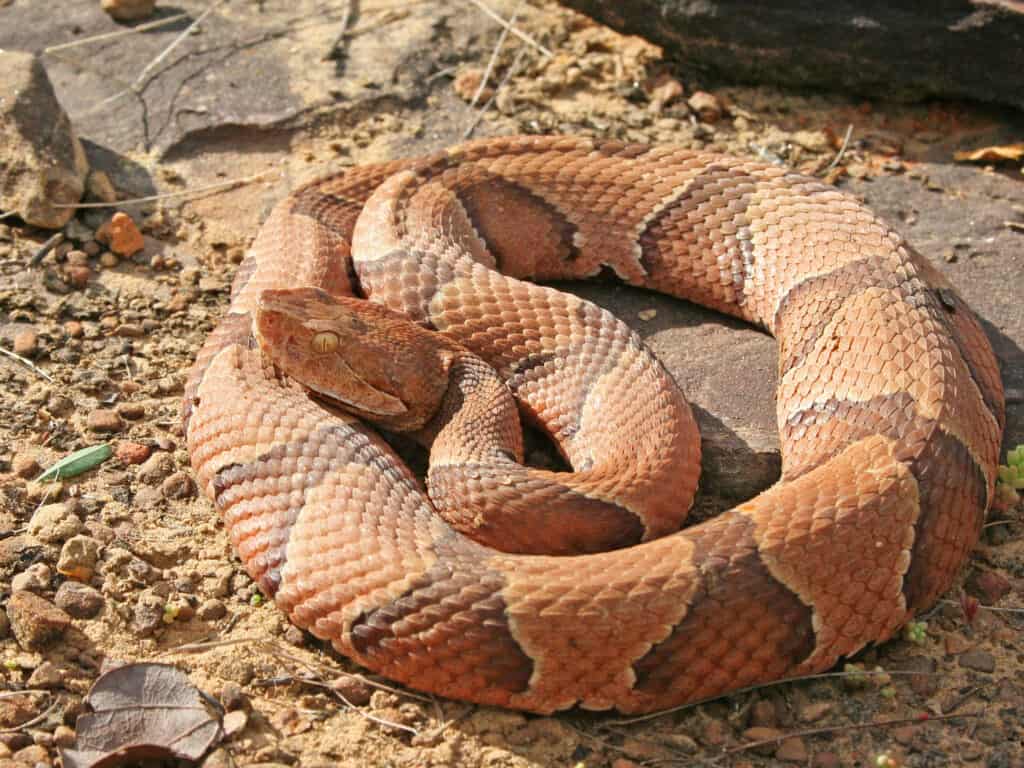
Snakes are not fun to run into for some people, and it is easy to assume all snakes are dangerous. This is a good rule of thumb to keep you safe. Since some snakes such as the copperhead are venomous, it is reasonable to want to avoid getting near one. However, are Copperheads aggressive?
Copperhead snakes are not aggressive unless provoked or threatened. If someone sees one on a walk, they should keep their distance. Copperheads like to hide under rocks, in bushes, and in other shaded areas, so watch out for children and dogs that like to explore those areas.
So, now that you know that copperheads are not going to attack you for sport, let’s dive deeper into how to avoid interactions with these snakes.
What Provokes a Copperhead Snake To Be Aggressive?
Copperhead snakes are not very aggressive but they are extremely territorial. So if you go near the area they have made their home or feel that they are in danger because of you, they will become aggressive.
If you live in an area that has a lot of copperhead snakes, you likely are used to looking out for them. Snakes are cold-blooded, meaning they do not regulate their body temperature. So, if it is hot out, expect these snakes to be in the shade.
They like to be under rocks because the temperature is cooler than the shade of a tree. However, that doesn’t mean you won’t find them in the shade of a tree, a bush, or other areas that provide shade.
Typically, there are some kids and teens who have brave souls, and they don’t quite have the fear level adults have around a snake. Instead, these adolescents like to go up to snakes and provoke, catch, or scare them away. It is usually because of ignorance that someone is bitten by a copperhead snake.
Copperheads Are More Aggressive When They Feel Threatened
Copperhead snakes will attack without warning when they feel threatened. Other snakes will rattle or coil up and get into a striking position. Copperheads will simply attack with seemingly no warning.
Luckily, their venom is not as fast and deadly like some other snakes, but if bitten you still need to get immediate medical attention. Some people are actually more allergic to copperhead venom than others.
However, this snake will not attack or become aggressive unless it feels threatened, so be careful not to provoke it.
A copperhead snake will be threatened when engaged in their area. They like to find an area and stay there. It becomes their home, and relocating them can be difficult because there is a chance they will come back.
How to Relocate a Copperhead Snake

Copperhead snakes like to stay where they have made their home, so moving them out of your yard won’t do much unless you have snake-proofed your fencing. Copperhead snakes will coil up and hold still if they see others, hoping to not be seen.
If they think they have been seen and feel threatened, they will bite. But, if you walk away, they will no longer feel threatened, but they will hopefully move and find a better place to hide, away from people. (Source)
If you want a copperhead snake moved out of your yard, you will be safest calling the local animal control. If you live in an area that is used to dealing with snakes, it will be relatively easy for them to remove the snake from your yard. The professionals will have the proper gear ready to catch and relocate the snake.
Then, you can buy and install some snake fencing. But you should never try and relocate a copperhead or any other venomous snake.
Snake fencing is light a tightly woven fence that has small holes in it to prevent and block snakes from going under your fencing. You can install it yourself or have a company install it. The fencing will go from under the ground and up a couple of feet. It can be attached to your current fence, and it will block snakes from entering your yard after you have moved them.
How to Avoid Getting Bitten by a Copperhead?
Copperheads want to avoid you as much as you want to avoid them. They don’t see us as prey but as threats. Because of that, the best way to avoid a bite from a copperhead is to actively avoid the snake yourself.
When you’re out on a hike, wear thick hiking boots, stick to the established trails, and, most importantly, watch where you’re putting your feet. Thick boots will protect you from the worst of a bite aimed at your foot, which would probably be one of the worst places to get bitten on a hike where you might need to use your foot to get out and get help.
Sticking to clear, established trails will help you be able to easily spot any snakes in your path. Copperheads and other snakes are often very easy to miss among leaves, sticks, and other forest litter. They may also hide under logs or rocks for shade, and stepping on those rocks might disturb them.
Above all, watch where you’re going. The best way to avoid a snake bite is to see the snake before it’s a problem, and then carefully walk a different way. Once you know where the snake is, you should be able to pretty easily find a different path that won’t disturb it. If that’s not an option, you could also just back up and wait until it moves on.
Dogs Are a More Common Victim Of The Copperhead
If a dog gets bitten by a copperhead snake, you will want to gently pick up your dog and take them to the vet. There are animal emergency hospitals, so if you have one in your area, take your dog to it. The best thing you can do is stay calm because there is a good chance that your dog will be okay. Take your dog to the vet promptly so that your vet can treat the bit as soon as possible.
Dogs are often on the receiving end of a bite from a copperhead snake because they sniff around rocks, bushes, trees, and other areas where snakes like to hide. As long as you stay calm and act fast, then your dog will hopefully be okay. But you do need to get help quickly.
